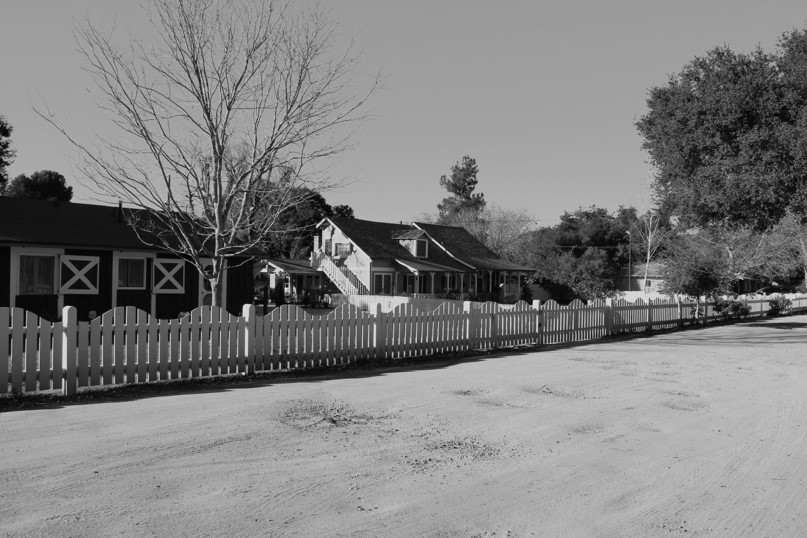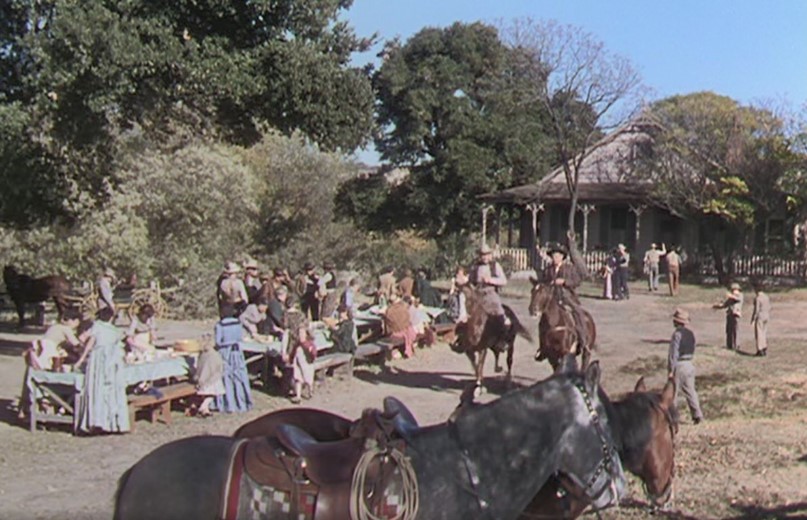|

1) "Haunted Trails" (1949). Click for original. All photos & screenshots courtesy of the writer.
|
When in need of a ranch set, most studios filming at Newhall's Monogram/Melody Ranch relied on a small ranch house, usually surrounded by a picket fence, and an adjacent barn — sets especially familiar to fans of Johnny Mack Brown, Jimmy Wakely, Whip Wilson and other Monogram productions.
Toward the end of the B-Western era, however, another ranch set — this one quite elaborate — began to appear in movies shot at the Monogram/Melody Ranch. It featured a large main house with a porch on two sides, extensive rail fencing, a modern stable and other outbuildings. Its original front had a peaked roof, and the porch extended along the front and left side, which had a gabled roof. It appeared extensively in Johnny Mack's "The Sheriff of Medicine Bow" (1948). The ranch also played the Bar-X Ranch in Whip Wilson's "Haunted Trails" (1949).
Photo No. 1 shows Whip riding into the ranch to elude heavies, and Photo No. 2 depicts Whip in the stable area behind the ranch.
The ranch also hosted Jimmy Wakely's "Outlaw Brand" (1948), as that fine old character actor Tom Chatterton's thoroughbred ranch. And it may have made its final appearance in Joel McCrea's "Wichita" (1955). Recently I learned the ranch made its first appearance in a Joel McCrea picture. But more about that shortly.

2) "Haunted Trails" (1949). Click for original.
|
I assumed for years the ranch I was seeking was either on the Monogram/Melody Ranch property or nearby but did not check out my hunch. Then, location researcher Jerry Schneider discovered the mystery ranch among a cluster of houses east of the Monogram/Melody Ranch (Photo No. 3).
In 2011, Kenny Stier published a photo of the ranch in Western Clippings No. 100, showing the stable and the original left side to the main house, which now serves as the house's front entrance.
Recently, I decided to track down the ranch's origins. Fortunately, my search led me to Newhall historian Leon Worden who suggested I contact the family of Wayne Valerius, the ranch owner from the late 1960s to 2005. Wayne Valerius died in 2017, but his widow Sally was an immense help.
My Newhall mystery ranch, she said, was built as a movie set for Paramount's 1946 remake of "The Virginian" starring Joel McCrea. In 1943, the studio decided to sell at auction its huge Agoura ranch facility, which had hosted Gary Cooper's 1929 version of "The Virginian" as well as many other classic films. Paramount was left only with its Hollywood backlot Western street and other sets. The company thus moved up to Newhall for much filming of the Joel McCrea remake.

3) Kenny Stier's photo, 2011. Click for original.
|
For railroad scenes, the crew used track built earlier in the area for the star's "Union Pacific" (1939). Filming was also done on the Monogram Western street and at the nearby Andy Jauregui ranch along Placerita Canyon Road, a mile or so from the Monogram ranch.
But for another spread required for the plot, including a party welcoming the new schoolmarm Barbara Britton to the community, Paramount built our mystery ranch.
In 1944, Signal Oil Company sold the property on which the new ranch was to be built to Ned and Nell Barmore. The next year, Paramount obtained rights to construct the ranch set for "The Virginian" there. Exterior scenes for the party (Photo No. 4) were filmed at the new set but also in the barnyard area of the Jauregui Ranch, especially for a scene in which McCrea, Sonny Tufts, Britton and Willard Robertson are standing at a fence with the new ranch set in the background, seemingly observing cowboys wrangling horses in the Jauregui corral.
The stable adjacent to the ranch house set also may have been constructed for "The Virginian," but I'm not certain. One comic scene involving McCrea and Tufts appears to have been filmed along one outer wall of the stable, but that scene could have been filmed at the Jauregui Ranch or at the studio.

4) Party scene from "The Virginian" (1946). Click for original.
|
What is clear is that when the production was completed. Paramount left the house set for Ned and Nell Barmore (who owned the ranch until 1949), and the elaborate fencing was installed that can be seen in Brown's "The Sheriff of Medicine Bow" (1948) and Wakely's "Outlaw Brand" (1948), the first two titles to feature the ranch's new look, as well as the thoroughbred track featured in "Outlaw Brand."
Sally Valerius complained that the house was poorly constructed and had no insulation. But Western movie location fans can be thankful this movie set became a residence for a succession of owners and has been saved from destruction.
In addition to those mentioned in the column, many thanks to L.A. actor, Realtor and longtime friend Brent Davis who provided me with the mystery ranch's title history and has been an invaluable source of location assistance over the years.
| 